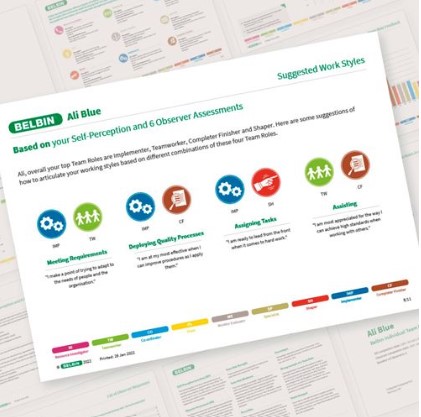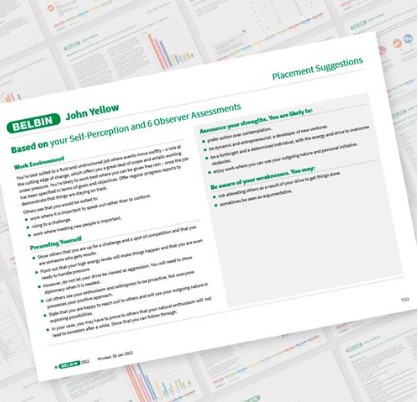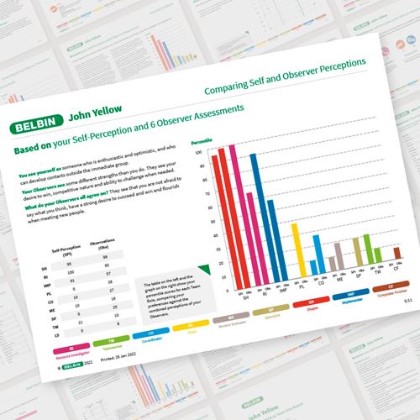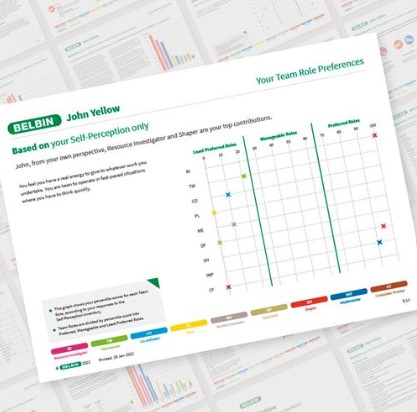The debate around remote and hybrid work looks set to rage on indefinitely.
Whilst high-profile employers such as Meta and Goldman Sachs have made headlines for their attitudes to remote working, a recent study quoted in Forbes claimed that remote and hybrid employers are hiring twice as quickly as those who demand a full-time office presence.
Advice on remote and hybrid work tends to centre around the logistics (your desk, chair and the technology available) and work-life balance and wellness (maintaining boundaries between work and home, switching off at the end of the day etc).
But how can you use your knowledge of your Belbin strengths (and weaknesses) to work more effectively within a remote or hybrid model? How can you make your strengths work for you?
At Belbin, we believe that knowing yourself is the starting point
Learning about your Belbin Team Roles can help you better understand your perspective and approach to work, your strengths, your optimum working environment and conditions, and how you tend to communicate with others.
Understanding these key features of the way you work gives you insights into why you might prefer some kinds of work to others, and enables you to manage expectations (your own and others’).
It can also help to navigate the challenges of communicating effectively with other team members in a hybrid working model.

Your strengths
When it comes to understanding and articulating your strengths, the Belbin Individual report is a great place to start.
The ‘Suggested Work Styles’ page is designed to give you an at-a-glance view of the primary contributions you make to a team, and how you like to work.
This can be a useful guide for yourself and others, enabling you to share the kinds of work you enjoy and how you tend to work best.
Your working environment: where and how do you work best?
Whilst we may not always have control over our location, we can still still shape our working environment by creating routines and strategies that fit our working styles.
The ‘Placement Suggestions’ page of the Belbin Individual report contains a ‘Work Environment’ section which suggests the situation in which you might work best.
This can help you with practical strategies to improve your remote working experience.
For example, if you struggle when out of a routine, can you create a timetable that will help you to organise your day?

A Resource Investigator needs interaction and might struggle with isolated working. If this is your preferred role, can you arrange regular times to meet online with colleagues to discuss your projects or relevant issues?
A Monitor Evaluator tends to enjoy thinking time but might procrastinate. If this is your tendency, what strategies can you deploy to ensure that ideas turn into actions? Are there (more action oriented) team members who might be able to help you with accountability?
What do others see?
In a hybrid environment where miscommunication is all too easy, it is important to understand the impact our behaviours have on others.
Once you have received your Belbin Individual report, based on your own perception, the next step is to ask for input from those you work with (called Observer Assessments) so that you can get a rounded view of how others see your contributions.
Without Observer Assessments, you are working in another kind of isolation when it comes to your behaviours, because you may be aspiring to one role while others see talents you didn’t know you had.

Once you have four or more completed Observer Assessments, an updated Belbin Individual report is available, showing the differences between your own views and those of others in your team.
This is an invaluable self-development tool, as well as a useful discussion starter when you meet with your manager or the rest of the team.
In this example, Ali Blue thinks he plays the Co-ordinator role, but his observer scores for this role are much lower.
Are his observers not seeing this role because of where and how the team is working, or is there another explanation to be explored? How could Ali make this role more prominent in his work so that others observe it as a strength too?

Unleash your potential
A change of environment might lead us to work in different ways. We might be required to think of innovative solutions to problems, cover for colleagues who are unavailable or take on different kinds of work.
Fortunately, although we all have our strengths or preferred ways of working, we also have a set of behaviours called ‘manageable roles’. These are latent strengths which can be called upon when needed and cultivated.
The current upheaval to our working lives is a great opportunity to take a leap outside our comfort zone and discover and develop talents we didn’t know we had.
The Belbin Individual report alerts you to these manageable roles and offers advice and guidance on how to develop them further in your work.
When things go wrong
Alongside the opportunities, virtual working presents new challenges.
Virtual communication can be more difficult without the nuances of tone or cues from body language.
In addition, so-called ‘attribution error’ is more common with remote working.
If someone is out of the office, we might assume that they are busy in a meeting or with a client. However, if a remote worker is unavailable, we are likely to be less charitable in attributing a reason, and deduce that they aren’t ‘putting in the time’.
Some may struggle to find their motivation when working alone.
Others may find themselves working at different times or may feel unable to ‘switch off’ with phones and laptops pinging away nearby.
All of this can lead to burnout, so it’s crucial to set your individual boundaries in light of the way you work and the most common difficulties you encounter in your working life.
If you can predict how you’re likely to respond to different situations, you’ll be one step ahead in forestalling problems.
Set yourself up for success
It’s crucial for you and your manager to communicate expectations clearly. If you’re fortunate enough to have a strong working relationship with your manager already, it’s likely to be easier to change tracks over to virtual working.
If not, using a common language to explore strengths and potential weaknesses is a great first step.
The language of Belbin Team Roles helps us to identify and articulate our contributions more clearly, and also to discuss the difficulties we encounter, in dispassionate terms.
What’s more, your Belbin Individual report is a practical tool, offering advice and guidance to help develop strategies for more effective working.
And once your manager has completed a Belbin report too, you can take the opportunity to analyse the relationship with our Working Relationship report, which compares the two sets of data and points up some areas for discussion.
This can be a great way to address new challenges (or even problems that preceded remote working) through a new lens.

Are you ready to begin your Belbin journey? There’s never been a better time.
You can find out more about the Belbin reports here or get in touch via our contact form.

